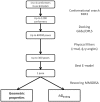Deciphering the glycan preference of bacterial lectins by glycan array and molecular docking with validation by microcalorimetry and crystallography
- PMID: 23976992
- PMCID: PMC3747263
- DOI: 10.1371/journal.pone.0071149
Deciphering the glycan preference of bacterial lectins by glycan array and molecular docking with validation by microcalorimetry and crystallography
Abstract
Recent advances in glycobiology revealed the essential role of lectins for deciphering the glycocode by specific recognition of carbohydrates. Integrated multiscale approaches are needed for characterizing lectin specificity: combining on one hand high-throughput analysis by glycan array experiments and systematic molecular docking of oligosaccharide libraries and on the other hand detailed analysis of the lectin/oligosaccharide interaction by x-ray crystallography, microcalorimetry and free energy calculations. The lectins LecB from Pseudomonas aeruginosa and BambL from Burkholderia ambifaria are part of the virulence factors used by the pathogenic bacteria to invade the targeted host. These two lectins are not related but both recognize fucosylated oligosaccharides such as the histo-blood group oligosaccharides of the ABH(O) and Lewis epitopes. The specificities were characterized using semi-quantitative data from glycan array and analyzed by molecular docking with the Glide software. Reliable prediction of protein/oligosaccharide structures could be obtained as validated by existing crystal structures of complexes. Additionally, the crystal structure of BambL/Lewis x was determined at 1.6 Å resolution, which confirms that Lewis x has to adopt a high-energy conformation so as to bind to this lectin. Free energies of binding were calculated using a procedure combining the Glide docking protocol followed by free energy rescoring with the Prime/Molecular Mechanics Generalized Born Surface Area (MM-GBSA) method. The calculated data were in reasonable agreement with experimental free energies of binding obtained by titration microcalorimetry. The established predictive protocol is proposed to rationalize large sets of data such as glycan arrays and to help in lead discovery projects based on such high throughput technology.
Conflict of interest statement
Figures








Similar articles
-
Fucose-binding lectin from opportunistic pathogen Burkholderia ambifaria binds to both plant and human oligosaccharidic epitopes.J Biol Chem. 2012 Feb 3;287(6):4335-47. doi: 10.1074/jbc.M111.314831. Epub 2011 Dec 14. J Biol Chem. 2012. PMID: 22170069 Free PMC article.
-
Synthesis of a selective inhibitor of a fucose binding bacterial lectin from Burkholderia ambifaria.Org Biomol Chem. 2013 Jun 28;11(24):4086-94. doi: 10.1039/c3ob40520f. Org Biomol Chem. 2013. PMID: 23673818
-
A fucose-binding superlectin from Enterobacter cloacae with high Lewis and ABO blood group antigen specificity.J Biol Chem. 2025 Feb;301(2):108151. doi: 10.1016/j.jbc.2024.108151. Epub 2024 Dec 30. J Biol Chem. 2025. PMID: 39743000 Free PMC article.
-
Glycan structures and their recognition roles in the human blood group ABH/Ii, Lea, b, x, y and Sialyl Lea,x active cyst glycoproteins.Glycoconj J. 2019 Dec;36(6):495-507. doi: 10.1007/s10719-019-09887-x. Epub 2019 Nov 26. Glycoconj J. 2019. PMID: 31773366 Review.
-
Biophysical Analyses for Probing Glycan-Protein Interactions.Adv Exp Med Biol. 2018;1104:119-147. doi: 10.1007/978-981-13-2158-0_7. Adv Exp Med Biol. 2018. PMID: 30484247 Free PMC article. Review.
Cited by
-
Screening of a Library of Oligosaccharides Targeting Lectin LecB of Pseudomonas Aeruginosa and Synthesis of High Affinity Oligoglycoclusters.Molecules. 2018 Nov 24;23(12):3073. doi: 10.3390/molecules23123073. Molecules. 2018. PMID: 30477231 Free PMC article.
-
The challenge and promise of glycomics.Chem Biol. 2014 Jan 16;21(1):1-15. doi: 10.1016/j.chembiol.2013.12.010. Chem Biol. 2014. PMID: 24439204 Free PMC article. Review.
-
Recent advances in employing molecular modelling to determine the specificity of glycan-binding proteins.Curr Opin Struct Biol. 2014 Oct;28:47-55. doi: 10.1016/j.sbi.2014.07.001. Epub 2014 Aug 7. Curr Opin Struct Biol. 2014. PMID: 25108191 Free PMC article. Review.
-
The lectin-like protein 1 in Lactobacillus rhamnosus GR-1 mediates tissue-specific adherence to vaginal epithelium and inhibits urogenital pathogens.Sci Rep. 2016 Nov 21;6:37437. doi: 10.1038/srep37437. Sci Rep. 2016. PMID: 27869151 Free PMC article.
-
Lectin-Like Molecules of Lactobacillus rhamnosus GG Inhibit Pathogenic Escherichia coli and Salmonella Biofilm Formation.PLoS One. 2016 Aug 18;11(8):e0161337. doi: 10.1371/journal.pone.0161337. eCollection 2016. PLoS One. 2016. PMID: 27537843 Free PMC article.
References
Publication types
MeSH terms
Substances
LinkOut - more resources
Full Text Sources
Other Literature Sources

